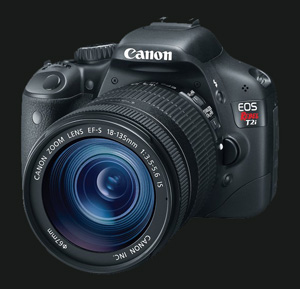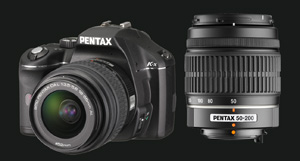Simple Full-size
For some casual snapshooters, size is really no object. In terms of usage, these users might use a camera very similarly to how they’d use a simple ultracompact – snapping a photo or two at social events, or taking casual photos around the house or room. In contrast to a simple ultracompact, a simple full-size camera doesn’t have portability as its main concern; you probably won’t be able to stuff it in your jeans pocket, and it might even require its own bag. Instead, the larger formfactor of a simple full-size camera often allows for better overall image quality.
Simple Full-size, premium: Pentax K-x with 18-55mm lens
 If size doesn’t matter and your budget reaches up to $500 or so, your best bet is a basic DSLR camera that provides superb image quality and quick response times that simply blow away anything you can find on a small-sensor compact or bridge camera, especially in low-light situations. While more advanced photographers appreciate them for their interchangeable lenses and manual controls, all of them still have fully automatic modes for simple point-and-shoot use.
If size doesn’t matter and your budget reaches up to $500 or so, your best bet is a basic DSLR camera that provides superb image quality and quick response times that simply blow away anything you can find on a small-sensor compact or bridge camera, especially in low-light situations. While more advanced photographers appreciate them for their interchangeable lenses and manual controls, all of them still have fully automatic modes for simple point-and-shoot use.
The Pentax K-x is Pentax’s entry-level DSLR, but you wouldn’t know it based on its featureset and image quality. While priced in the same sub-$500 range as Canon’s Rebel XS and Nikon’s D3000, the Pentax K-x’s plethora of features rival many midrange DSLRs, with fast-firing 5fps continuous shooting, sensor-based image stabilization that works with any lens, expansive 11-point autofocus system, and even 720p HD video. Image quality on the K-x, especially in low-light situations, is a bit better than the Rebel XS, and both easily outclass the Nikon D3000.
- 12MP resolution
- 27-83mm (3x) zoom range
- f/3.5-5.6 aperture
- 1280×720, 24fps video
- Sensor-based Image stabilization
- 516g (18.2oz) – not including lens
- 122.0 x 91 x 69.0 mm (4.89 x 3.6 x 2.7 in) – not including lens
- 420 shots battery life (CIPA)
- $490 on Amazon
Simple Compact, midrange: Canon SD3500 IS
For a midrange budget, there really aren’t any value-added propositions for moving up a size class for this user group; no cameras exist that offer significantly better image quality for the price, so one may as well opt for the Canon SD3500 IS for increased portability. See the recommendation for Simple Ultracompact, midrange for the description.
Simple Compact, budget: Canon SD1300 IS
For the budget price range, there really aren’t any value-added propositions for moving up a size class for this user group; no cameras exist that offer significantly better image quality for the price, so one may as well opt for the Canon SD1300 IS for increased portability. See the recommendation for Simple Ultracompact, budget for the description.
Workhorse Full-size, premium: Canon Rebel T2i with 18-135mm lens
 The Canon Rebel T2i is a midrange DSLR, well spec’d with a plethora of features and the best image quality in its sub-$1000 range. The T2i has one of the more capable autofocus systems around and boasts the best high-ISO performance for low-light situations. It also has the most comprehensive video capability around, with 1080p recording and even an input for attaching an external microphone. While the basic kit, priced at about $800, comes with an 18-55 IS lens, spending about $200 more will net you the much more versatile 18-135 IS, equivalent to about 29-216mm and giving you just enough zoom (wide-angle and telephoto reach) to handle the majority of shooting situations, all without ever having to stop and swap different lenses. If you’re willing to take the size, convenience and speed tradeoff of using multiple lenses, however, a lens combo of the 18-55 IS kit lens and 55-250 IS telephoto lens will run about the same price, and offer slightly better image quality and a much more extensive range (roughly 29-400mm, or nearly twice the telephoto reach).
The Canon Rebel T2i is a midrange DSLR, well spec’d with a plethora of features and the best image quality in its sub-$1000 range. The T2i has one of the more capable autofocus systems around and boasts the best high-ISO performance for low-light situations. It also has the most comprehensive video capability around, with 1080p recording and even an input for attaching an external microphone. While the basic kit, priced at about $800, comes with an 18-55 IS lens, spending about $200 more will net you the much more versatile 18-135 IS, equivalent to about 29-216mm and giving you just enough zoom (wide-angle and telephoto reach) to handle the majority of shooting situations, all without ever having to stop and swap different lenses. If you’re willing to take the size, convenience and speed tradeoff of using multiple lenses, however, a lens combo of the 18-55 IS kit lens and 55-250 IS telephoto lens will run about the same price, and offer slightly better image quality and a much more extensive range (roughly 29-400mm, or nearly twice the telephoto reach).
- 18MP resolution
- 18-55 lens: 29-88mm (3x) zoom range; 55-250 lens: 88-400mm (4.5x) zoom
- f/3.5-5.6 aperture
- 1920×1080, 30/24fps (1080p) video
- Lens-based Image stabilization
- 475g (16.8oz) – not including lens
- 130 x 97 x 76 mm (5.1 x 3.8 x 3.0 in) – not including lens
- 470 shots battery life (CIPA)
- $995 on Amazon; $1019 on Amazon for 18-55 + 55-250 kit ($799 + $210)
Workhorse Full-size, midrange: Pentax K-x with 18-55 and 50-200 lenses
 As mentioned in the Simple full-size recommendation, the Pentax K-x is a feature-rich a camera with capabilities closer to midrange cameras like the $1000 Rebel T2i package than the entry-level DSLRs it’s priced against – in fact it’s a much better value proposition than even the Rebel T2i, unless you’re very interested in using a DSLR for video production. In addition to its superb image quality, the K-x bundles many advanced features that are missing from other budget DSLRs, such as fast-firing 5fps continuous shooting, sensor-based image stabilization to reduce blur even with non-IS lenses, expansive 11-point autofocus system, and even 720p HD video that will afford the workhorse photographer more capabilities in the more difficult photographic situations they’re likely to explore, such as fast-action subjects or low-light scenes.
As mentioned in the Simple full-size recommendation, the Pentax K-x is a feature-rich a camera with capabilities closer to midrange cameras like the $1000 Rebel T2i package than the entry-level DSLRs it’s priced against – in fact it’s a much better value proposition than even the Rebel T2i, unless you’re very interested in using a DSLR for video production. In addition to its superb image quality, the K-x bundles many advanced features that are missing from other budget DSLRs, such as fast-firing 5fps continuous shooting, sensor-based image stabilization to reduce blur even with non-IS lenses, expansive 11-point autofocus system, and even 720p HD video that will afford the workhorse photographer more capabilities in the more difficult photographic situations they’re likely to explore, such as fast-action subjects or low-light scenes.
The two-lens combination of the 18-55 and 50-200 provide a range of 27-300mm (11.1x zoom), which should easily handle a wide range of subjects from wide, sweeping landscape shots of some natural vista, to the a detailed close-up of an architectural detail high up on the ceiling, though it does come at the cost of cumbersome switching of lenses. Though it raises the price significantly, one can also opt for the Tamron 18-200 lens, which provides the same 27-300mm range all in one lens, for about $200 more (or maybe $150 if you sell the now-redundant 18-55 lens).
One drawback for workhorse users looking into the K-x is the smaller Pentax system, compared to expansive lens and accessory selection (and used equipment market) for more popular brands such as Canon and Nikon. While the upgrade options are limited in the very elite range of equipment (the kind that professionals for news or sports agencies might use), the problem likely won’t be an issue for the vast majority who don’t ever imagine themselves spending $1000+ on a lens or $2000+ on a camera. At the entry-level and midrange, both Pentax and third-parties like Sigma and Tamron produce a selection equivalent to what’s available in Canon, Nikon, and other camera systems.
- 12MP resolution
- 27-300mm (11.1x) zoom range
- f/3.5-5.6 aperture
- 1280×720, 24fps video
- Sensor-based Image stabilization
- 516g (18.2oz) – not including lens
- 122.0 x 91 x 69.0 mm (4.89 x 3.6 x 2.7 in) – not including lens
- 420 shots battery life (CIPA)
- $586 on Amazon; $779 on Amazon for $490 18-55 kit and $289 Tamron 18-200 lens.
Workhouse Full-size, midrange: Panasonic FZ40
 The market for the big, hulking ultrazooms of yesteryear have somewhat evaporated in the budget and midrange categories – for the majority of consumers, the advantages of having a portable formfactor like the Sony HX5 or Panasonic TZ/ZS/ZR series cameras is so enormous that no amount of expanded features or capability would sway them towards a larger camera. Nonetheless, there are certain advantages to larger cameras like the FZ40: even bigger “megazoom” lenses, better ergonomics (there’s a real handgrip, and generally much more camera to hold onto), an electronic viewfinder in addition to the rear LCD for composing images, hotshoe for attaching external flash units, and manual controls that often aren’t found on compact ultrazooms for marketing reasons.
The market for the big, hulking ultrazooms of yesteryear have somewhat evaporated in the budget and midrange categories – for the majority of consumers, the advantages of having a portable formfactor like the Sony HX5 or Panasonic TZ/ZS/ZR series cameras is so enormous that no amount of expanded features or capability would sway them towards a larger camera. Nonetheless, there are certain advantages to larger cameras like the FZ40: even bigger “megazoom” lenses, better ergonomics (there’s a real handgrip, and generally much more camera to hold onto), an electronic viewfinder in addition to the rear LCD for composing images, hotshoe for attaching external flash units, and manual controls that often aren’t found on compact ultrazooms for marketing reasons.- 14MP resolution
- 25-600mm (24x) zoom range
- f/2.8-5.2 aperture
- 1280×720, 30fps video
- Lens-based Image stabilization
- 454g (16z)
- 120 x 79 x 91 mm (4.7 x 3.1 x 3.6 in)
- 580 shots battery life (CIPA)
- $300 on B&H Photo
Workhorse Full-size, budget: Panasonic ZR3
Compact ultrazooms like the ZR3 have all but wiped out the ultrazoom market in the lower price brackets – thus today you won’t find a more capable budget camera than Panasonic’s exceptional ZR3, no matter how large you’re willing to go. See the recommendation for Workhorse Compact, budget for the description.


I gotta say that for the past few generation of beginner DSLR’s, I’ve been quite impressed by Pentax and let down by Canon / Nikon. Pentax has been including weather sealing and 11-point AF for a couple / few generations now, and of course in-camera stabilization which is one thing I doubt Nikon and Canon will ever adopt… Now, the K5 is pretty dang impressive too, etc. etc. I think Pentax is a very good choice for any advanced hobbyist photographer, or even certain pros depending on the industry.
=Matt=